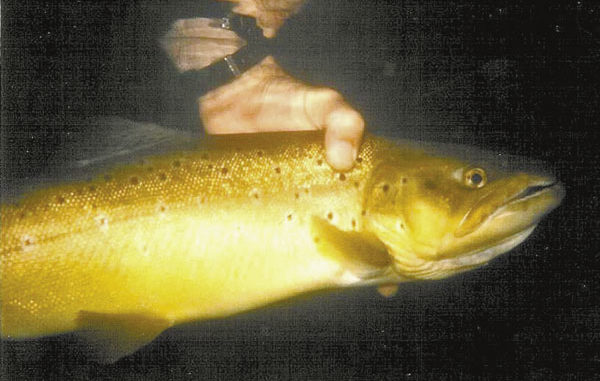
I believe in the merits of catch-and-release, but I’m not a hard-core purist like many Trout Unlimited members. I like the taste of trout, and once in a great while, I will keep a wild trout, especially if I’m camping in wild-trout territory.Most biologists agree that keeping fish in moderation will not adversely affect the trout population. In fact, Steve Moore, the head fisheries biologist for the Great Smoky Mountains Park, says limited thinning may even be beneficial.
If the stream I’m fishing is hatchery-supported, I will keep only enough for a meal. Any trout caught after that are released. A frozen trout is a poor substitute for one fresh from a mountain stream, whether it was born there or placed there.
As more and more people take up the fine sport of trout fishing, even remote, backcountry trout streams are getting greater fishing pressure than ever. If we want to continue to have quality trout fishing for us and for future generations, we must assume responsibility for these precious resources and help them survive. Other than applying stricter harvest regulations, the most effective methods of preserving the resource is for more anglers to limit their catches and practice catch-and-release.
For catch-and-release to work, though, it must be done properly. You can’t horse a trout to the bank, drag it over rocks and sand, jerk the hook out of its mouth, keep it out of water for an inordinate amount of time, and expect it to survive when you finally put it back in the stream. If you fish that way, you may as well stick the trout in your creel. It has about the same chances of surviving.
Jerry L. West, professor emeritus of biology at Western Carolina University in Cullowhee, said studies show that trout definitely undergo physiological changes when they are hooked.
“Their stress hormones shoot up, and their blood sugar increases,” he said, and the longer the trout is kept on the line, the more it is adversely affected by these physiological changes. To reduce stress on a fish, keep fight time to a minimum and return the fish to the water as quickly as possible.
Jim Borawa, fishery research coordinator for the N.C. Wildlife Resources Commission, suggests using a net only when it’s absolutely necessary. “The ideal situation,” he said, “would be never to touch the trout, but to keep it in the water and gently remove the hook with forceps or needlenose pliers.”
If you must handle a trout, West stressed the importance of wetting your hands first or using a special glove designed for handling trout. A trout’s protective slime covering easily can be disturbed by dry hands or a net.
Proper handling of fish also is important. Don’t hold it head up. Gently cradle it in your hands, taking care not to squeeze the throat or body cavity areas and damage vital organs. Keep your fingers away from the gills. To minimize wiggling, hold the trout upside down. It usually will remain still enough for you to remove the hook.
Sometimes, even a careful angler will hook a trout deep in the throat or deep in its flesh. If it’s apparent that you won’t be able to easily remove the hook, both West and Borawa said the best procedure is to snip the line close to the hook and then release the trout, rather than risk further injury by trying to remove the imbedded hook.
“If the hook is left in the trout,” Borawa said, “it’s sort of like having a splinter in your hand. It’ll eventually drop out.”.
When you’re ready to return the fish to the water, grasp it gently, point its head into the current, make sure the gills are working properly, and let the fish swim out of your hands. If the fish is exhausted after a prolonged fight, you may have to move it to quiet water to revive it.
Use barbless hooks when fishing a wild-trout stream. They make the release process much easier and cause less damage than a barbed hook. If you have trouble finding barbless hooks, take needlenose pliers and mash the barb down. It’s a less expensive than buying barbless hooks.
Occasionally, though, no matter how hard you try not to, you might kill or severely injure a trout.
“If you’re on a stream that allows harvest, that would be a good time to keep a fish,” Borawa said. But if you’re on a catch-and-release stream, “leave the trout in the water. You’re just accelerating the natural course of events.”
Catch-and-release does not have to be applied to all streams, of course. North Carolina has numerous streams that are regularly stocked with hatchery-raised trout, and these streams have generous creel limits and no size or lure restrictions. Still, if everyone kept a limit each time he fished, even the heavily-stocked streams would soon be barren. Catch and keep only what you can consume. Let the rest go. The streams that need our consideration are, first, our native brook trout streams, and second, our wild brown and rainbow trout streams. No brook trout should ever be killed — they’re too beautiful. Besides, they are our only true native salmonid. As for keeping brown or rainbow trout, think of the consequences before you put anything in your creel.
We can have our wild fish and protect them, too — by practicing catch and release.
• • •
Hatchery-supported waters open for 2010 on Saturday, April 3. The season on Cherokee Enterprise waters opens on Saturday March 27. Stockings usually are done in March.




Be the first to comment